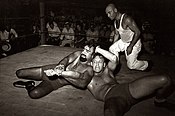| Bruno Sammartino | |
|---|---|
 Sammartino as WWWF World Heavyweight Champion in 1971 | |
| Birth name | Bruno Leopoldo Francesco Sammartino |
| Born | October 6, 1935 Pizzoferrato, Abruzzo, Kingdom of Italy |
| Died | April 18, 2018 (aged 82) Pittsburgh, Pennsylvania, U.S. |
| Spouse(s) |
Carol Sammartino
(m. 1959) |
| Children | 3; including David Sammartino |
| Professional wrestling career | |
| Ring name(s) | Bruno Sammartino |
| Billed height | 5 ft 10 in (178 cm)[1] |
| Billed weight | 265 lb (120 kg)[1] |
| Billed from | Pittsburgh, Pennsylvania |
| Trained by | Ace Freeman Rex Peery[3] |
| Debut | October 23, 1959 |
| Retired | August 19, 1987 |
| Part of a series on |
| Professional wrestling |
|---|
 |
Bruno Leopoldo Francesco Sammartino (October 6, 1935 – April 18, 2018) was an Italian-American professional wrestler. He is best known for his time with the World Wide Wrestling Federation (WWF, now WWE). Sammartino's 2,803-day reign as WWF World Heavyweight Champion is the longest in the championship's history as well as the longest world title reign in WWE history.
Born in Italy to a family of seven, Sammartino grew up in poverty. As a child, Sammartino survived the German occupation of Italy during World War II. In 1950, he came to the United States with his family, where they would settle in Pittsburgh. Sammartino would later take up bodybuilding before beginning his career as a professional wrestler in 1959.
Dubbed "the Italian Strongman”[2] and "the Strongest Man in the World"[4] early in his career, Sammartino later earned the title "the Living Legend".[5] Known for his powerful bearhug[3][6] finishing move,[7] Sammartino wrestled for various territories in the National Wrestling Alliance (NWA) before joining the WWWF territory.
Already recognized as a future star, Sammartino won the WWWF World Heavyweight Championship in 1963 after beating the inaugural champion, Buddy Rogers, in 48 seconds. He then held the title for a reign of a record 2,803 days – nearly 8 years. While doing so, Sammartino became a popular attraction in Madison Square Garden, selling out the arena numerous times throughout his career.[a] Sammartino would later reclaim the WWF Heavyweight Championship in 1973 for another reign of 1,237 days before gradually retiring from full-time competition.
After his retirement, Sammartino became a vocal critic of the drug use and raunchier storylines that became prevalent in the professional wrestling industry after his retirement but he reconciled with WWE in 2013 and headlined their Hall of Fame ceremony that year. Terry Funk commented that Sammartino "was bigger than wrestling itself".[8]
- ^ a b "Bruno Sammartino WWE profile". WWE.com. Retrieved February 16, 2022.
- ^ a b Shields, Brian; Sullivan, Kevin (2012). WWE Encyclopedia: Updated & Expanded. DK. pp. 56–57. ISBN 978-0-7566-9159-2.
- ^ a b Hornbaker, Tim (2012). Legends of Pro Wrestling: 150 Years of Headlocks, Body Slams, and Piledrivers. Sports Publishing. ISBN 978-1613210758.
- ^ Hornbaker, Tim (2015). Capitol Revolution: The Rise of the McMahon Wrestling Empire. ECW Press. pp. 212–213. ISBN 978-1-77041-124-1.
- ^ Cite error: The named reference
Schrammwas invoked but never defined (see the help page). - ^ Davies, Ross (2001). Bruno Sammartino. Rosen Publishing Group. pp. 23–24. ISBN 978-1435836259.
- ^ Murphy, Jan (October 1, 2014). "Jim Myers: The man behind the Animal". SLAM! Sports. Canoe.com. Archived from the original on January 28, 2020. Retrieved September 7, 2016.
- ^ Barrasso, Justin (April 18, 2018). "'The Joe DiMaggio of Professional Wrestling': Terry Funk Remembers Bruno Sammartino". Sports Illustrated. Retrieved January 3, 2020.
Cite error: There are <ref group=lower-alpha> tags or {{efn}} templates on this page, but the references will not show without a {{reflist|group=lower-alpha}} template or {{notelist}} template (see the help page).